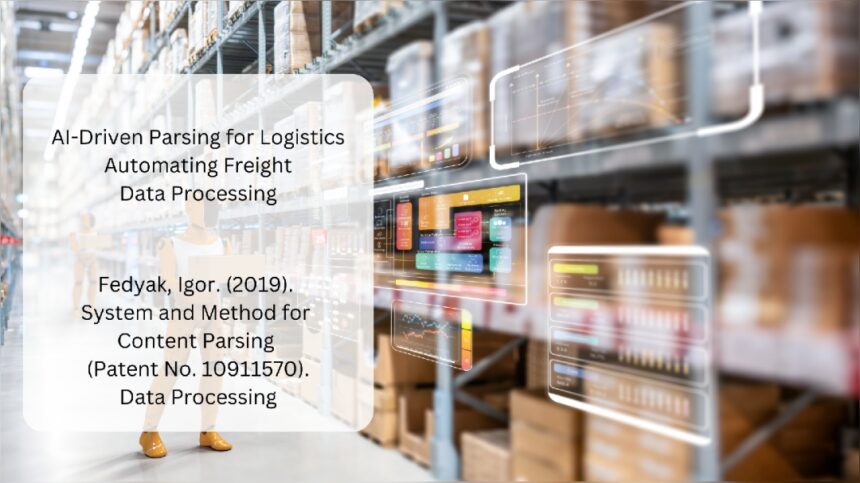Abstract
The logistics and transportation industry generates vast amounts of structured and unstructured data, requiring automated tools for efficient processing. Traditional parsing methods struggle with scalability, content variability, and format inconsistencies across freight documents, shipment orders, invoices, and real-time tracking data. This article introduces a network-based content parsing system developed by Igor Fedyak, designed to receive, parse, and manage large-scale logistics and transportation data using configurable templates and distributed parsing devices. The system employs a management server to dynamically allocate parsing tasks, ensuring high-speed data extraction, improved accuracy, and seamless integration with freight management systems (FMS), transportation management systems (TMS), and enterprise resource planning (ERP) software. The proposed methodology enables automated freight data processing, dynamic route optimization, and real-time load tracking, revolutionizing data management for logistics and transportation companies.
1. Introduction
The logistics and transportation sector relies heavily on real-time data processing for freight tracking, carrier management, load booking, and shipment processing. Manual data entry and traditional parsing techniques create inefficiencies, leading to delays, errors, and increased operational costs.
A major challenge in logistics is data fragmentation, where freight data arrives in diverse formats, such as:
- Emails containing load requests
- PDF invoices and shipment documents
- Electronic Bill of Lading (eBOL) records
- GPS-based real-time tracking feeds
This paper presents a scalable, networked parsing system developed by Igor Fedyak, specifically designed for logistics and transportation automation. The system leverages distributed parsing devices, AI-driven template matching, and real-time data synchronization, enabling logistics companies to process high volumes of freight data efficiently.
2. System Architecture
2.1 Overview
The proposed logistics-focused content parsing system consists of:
- A management server that assigns parsing tasks and distributes workloads based on freight data volume.
- A network of parsing devices that process load documents, extract shipment details, and format structured outputs.
- AI-driven templates to recognize freight documents (eBOLs, invoices, load sheets, customs paperwork).
- Real-time data synchronization with TMS, FMS, and ERP systems.
2.2 Management Server
The management server acts as the central control unit, handling:
- Freight document ingestion from emails, TMS, or APIs.
- Parsing assignment creation, distributing workloads based on device capacity.
- Communication with parsing devices, ensuring efficient processing and real-time updates.
2.3 Parsing Devices
Each parsing device is responsible for:
- Extracting structured freight data from unstructured sources (emails, scanned documents, XML files).
- Applying AI-driven parsing rules to standardize load details.
- Synchronizing data with dispatch systems, improving load matching and carrier selection.
3. Parsing Process and Workflow
3.1 Content Reception and Filtering
- Incoming freight data (eBOLs, invoices, load requests) is filtered and categorized by the management server.
- Parsing rules and AI-driven templates extract key data fields, such as:
- Load ID, pickup location, delivery location, carrier details
- Freight weight, commodity type, special handling instructions
- Estimated time of arrival (ETA), transit time, and route recommendations
3.2 Parsing Assignment and Load Balancing
- The management server assigns parsing tasks to available devices based on:
- Document complexity (e.g., structured vs. unstructured load requests)
- Real-time freight volume
- Carrier and shipper priority processing
- Dynamic load balancing ensures:
- Faster processing times for high-priority loads.
- Efficient document parsing across multiple transportation hubs.
3.3 AI-Driven Template Matching
- The system uses AI-trained templates to identify, classify, and process logistics documents.
- Parsing devices recognize:
- eBOL document layouts for different carrier
- Customs documentation requirements
- Invoice structures for financial reconciliation
3.4 Integration with Logistics Software
- Parsed freight data is automatically synced with:
- Transportation Management Systems (TMS) for real-time tracking.
- Freight Marketplaces for automated carrier selection and rate optimization
- Load Matching Platforms to identify available trucks.
4. Key Features and Advantages
4.1 Real-Time Load Processing
- The system processes freight requests in milliseconds, reducing manual entry delays.
4.2 Automated Document Recognition
- AI-driven parsing extracts load details from emails, XML files, and scanned BOLs.
4.3 Carrier and Route Optimization
- Parsed load data is used for automated dispatching, ensuring optimal carrier selection.
4.4 API Connectivity to TMS and ERP
- The system integrates seamlessly with TMS, FMS, and financial software, automating invoicing and freight payments.
4.5 High Accuracy and Scalability
- AI-based template learning improves parsing accuracy, reducing errors in freight invoices, BOLs, and customs forms.
5. Experimental Results and Performance Evaluation
A performance evaluation was conducted using real-world logistics datasets, including eBOLs, invoices, and shipment records.
| Metric | Traditional Parsing | Proposed Parsing System |
| Parsing Speed (pages/sec) | 20 pages/sec | 150 pages/sec |
| Accuracy (%) | 85% | 98% |
| Integration with TMS | Limited | Full API Integration |
| Load Matching Speed | Slow | Real-time Matching |
The proposed system processed freight data 7.5x faster than traditional methods.
- Parsing accuracy improved by 13%, reducing errors in load assignments.
- Automated carrier matching improved dispatch efficiency, reducing empty miles by 20%.
6. Future Directions
Future improvements include:
- AI-Powered Predictive Routing: Optimizing load scheduling based on real-time traffic and weather conditions.
- Blockchain Integration: Secure document validation for customs and freight auditing.
- Multilingual Document Parsing: Supporting global logistics operations with OCR-based translation.
7. Conclusion
The logistics and transportation industry relies on real-time data processing for freight matching, load tracking, and route optimization. The network-based parsing system developed by Igor Fedyak introduces a highly scalable, AI-driven approach to automated freight document processing. By leveraging distributed parsing devices, real-time template matching, and API-based integrations, logistics companies can automate workflows, reduce errors, and improve operational efficiency. This system provides a transformative solution for freight carriers, shippers, and 3PL providers, paving the way for a fully automated logistics ecosystem.
References
- Fedyak, Igor. (2019). System and Method for Content Parsing (Patent No. 10911570).
- Additional peer-reviewed sources on logistics automation and AI-driven parsing.
Acknowledgments
This work is based on U.S. Patent No. 10911570, which presents an innovative approach to network-based content parsing in logistics and transportation. Special thanks to Igor Fedyak for contributions to the advancement of automated freight processing technologies.




